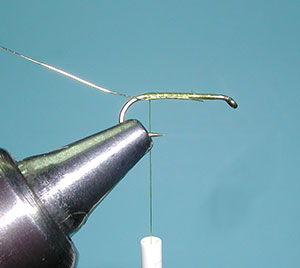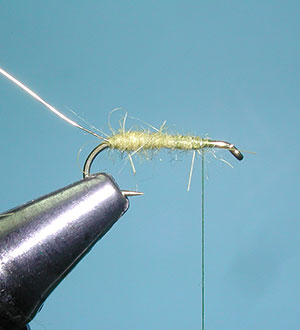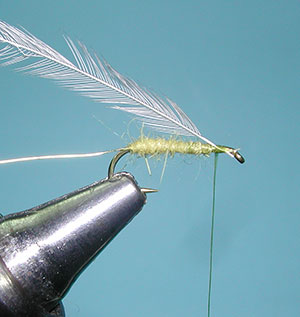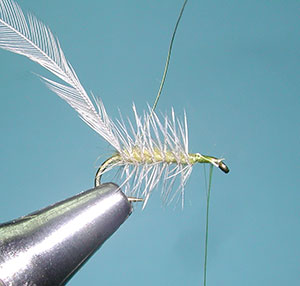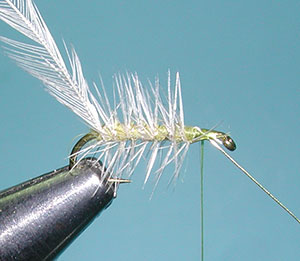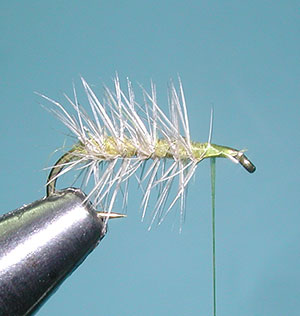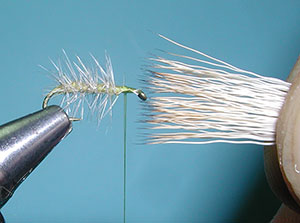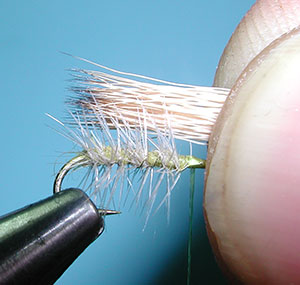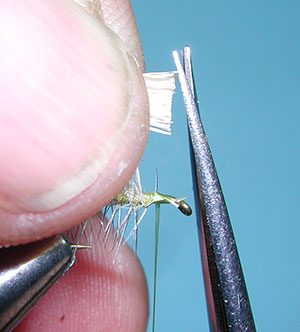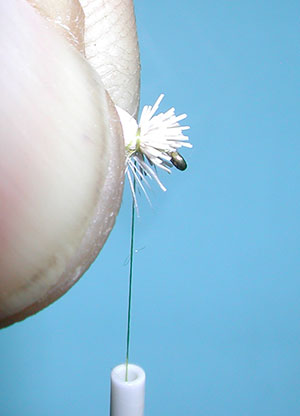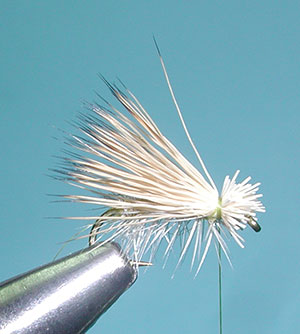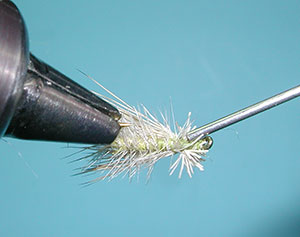Elk Hair Caddis
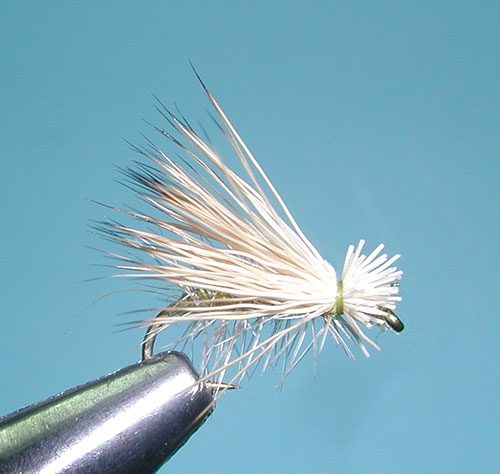
Olive Elk Hair Caddis
Tying Instructions
| Materials
to Order Material, click the link |
|
|---|---|
| Hook | TMC 100sp-bl #12-18 or TMC 101 #12-18 |
| Thread | Veevus Light Olive 12/0 |
| Body | Olive Haretron Dubbing |
| Rib | Extra Small Gold Wire |
| Wing | Natural Bull Elk Hair |
| Hackle | Light Dun, Palmered |


Al Troth
This is probably one of the most popular dry flies used in the Sierra. Al Troth originally designed this fly as a wet fly in 1957 on Loyalsock Creek in Pennsylvania. He soon discovered the floating qualities of Elk Hair and found that he actually had created a great dry fly. Al brought the fly with him to Montana where he was guiding and it became popular due to it’s simplicity, effectiveness and adaptation. For many fly fishers, the Elk Hair Caddis, is one of the primary flies to have in your flybox.
Hook
The Elk Hair Caddis (EHC) is usually tied on a standard dry fly hook, like a TMC 100. Newer hooks, like the TMC100sp-bl, provide a barbless point with a heavy wire and and an extra wide gape. The EHC can be tied with many variations of color, ie Tan , Black, Brown. However, there are a few different ways to tie this pattern, too. In this tutorial I’m using the technique described by Al Troth, using a wire rib and wrapping the hackle back to the rear of the fly, 4-5 wraps.
Hackle
Another popular method is to tie the hackle in at the rear by the butt and wrap the hackle forward without the need of a wire ribbing. Al Troth did not trim the upper fibers of the hackle but you will often see this done in order to lay the wing closer to the body. The hackle is meant to represent the legs of the caddis and is not designed to float the fly, as the wing does that. The hackle fibers should not extend beyond the gape of the hook, so you may want to use a hackle that is one size smaller than the hook. In addition, the body is usually tied level although some tie it with a taper on both ends or a reversed taper. A taper towards the eye of the hook allows the elk hair wing to lie down better.
Body and Wing
Al used Hare’s Mask dubbing for the body on his original fly but often you will find Antron, Superfine, and other synthetics being used. The wing is the most important component of this fly. You need to select hair that is fairly stiff but compressible. Too soft…and the hair will flare too much. Bull Elk Hair will have these characteristics. The length of the wing should be the same as the hook length. Al would trim off the butts after tying in the wing, the butts representing the head of the fly. The fly was finished with wraps behind the head and a whip finish. Cement was applied to the wraps and allowed to get tacky. Then, the wrap would be compressed by your L.H. thumbnail to splay the wing while the R.H. thumbnail pressed the butts upward. This really helps to keep the eye clear.
Today, some tiers prefer to trim the wing to length prior to securing the wing to the shank. This technique allows for fewer thread wraps and the opportunity to apply a thread wrap within the hair butts, finishing with a whip finish beneath the head, and applying no head cement.
Variations
The near cousin of the Elk Hair Caddis is the Deer Hair Caddis, a variation that Jim Schollmeyer devised for smaller, darker caddis impressions. The fly pattern is particularly good on small streams with riffles and runs. The hackle is usually removed on slower moving streams to allow the fly to sit deeper in the surface film. Within the Sierra, the caddis hatch is mostly from June through October.
Hans Weilenmann created a variation using just CDC and Elk. By attaching the CDC tip to the hook bend and wrapping the hackle forward, fine fibrils emerge from the body giving the fly a very active appearance.
Presentations
Many will fish the fly on a dead drift on a stream and let it swing downstream. Dance the pattern across the current and skitter for a few seconds before making another cast. The skitter will often provoke a strike.
Variations
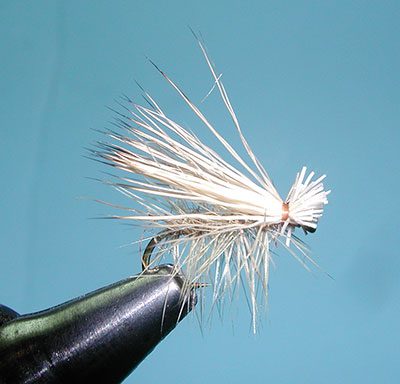
Tan Elk Hair Caddis
| Hook | TMC 100sp-bl #12-18 |
| Thread | Veevus Tan 12/0 |
| Body | Hareline Dubbing Hare's Ear |
| Ribbing | Extra Small Gold Wire |
| Wing | Natural Bull Elk Hair |
| Hackle | Ginger, Palmered |
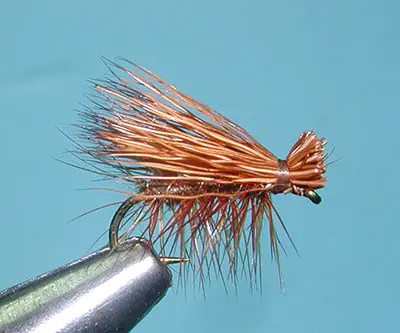
Brown Elk Hair Caddis
| Hook | TMC 100sp-bl #12-18 |
| Thread | Veevus Brown 10/0 |
| Body | Hareline Dubbing Chocolate Brown |
| Ribbing | Extra Small Gold Wire |
| Wing | Brown Bull Elk Hair |
| Hackle | Brown, Palmered |
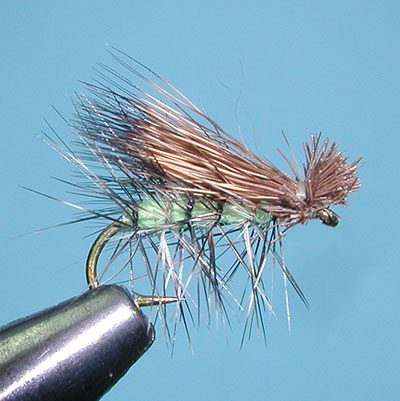
Deer Hair Caddis, Yellow
| Hook | TMC 100sp-bl #12-18 |
| Thread | Veevus 12/0 Light Cahill |
| Body | Sulphur Yellow Superfine |
| Wing | Natural Comparadun Deer Hair |
| Hackle | Grizzly, Palmered |

Black Elk Hair Caddis
| Hook | TMC 100sp-bl #12-18 |
| Thread | Veevus 12/0 Black |
| Body | Peacock Herl |
| Ribbing | Extra Small Gold Wire |
| Wing | Black Bull Elk |
| Hackle | Grizzly, Palmered |

CDC & Elk
| Hook | TMC 100sp-bl #12-18 |
| Thread | Veevus Gray 14/0 |
| Body | Medium Dun CDC |
| Wing | Dun Elk Hair |
| Hackle | Medium Dun CDC |


